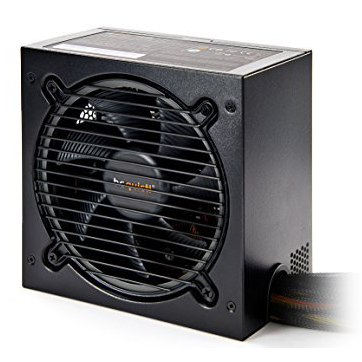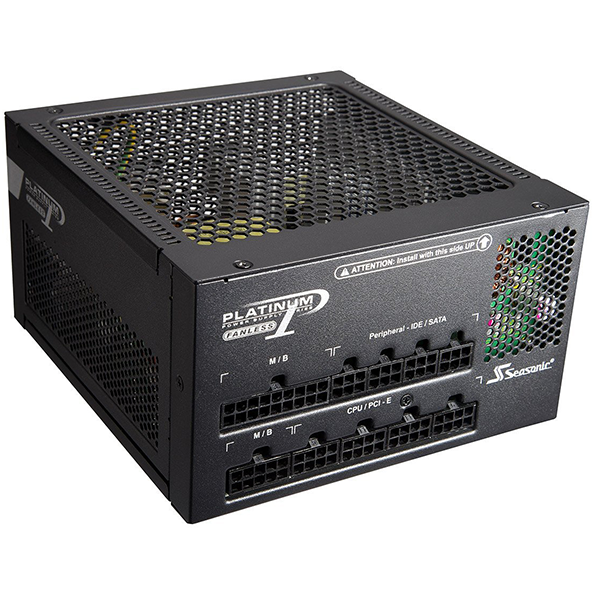EVGA SuperNOVA 550 G2 PSU Review
EVGA introduced two new low-capacity G2 PSUs. Today, we evaluate the 550 G2 model made by Super Flower, which features 80 Plus Gold efficiency.
Why you can trust Tom's Hardware
Load Regulation, Hold-Up Time And Inrush Current
To learn more about our PSU tests and methodology, please check out How We Test Power Supply Units.
Primary Rails And 5VSB Load Regulation
Load Regulation testing is detailed here.
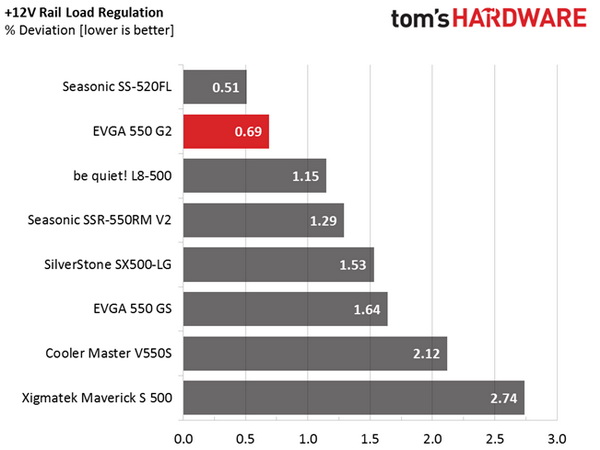
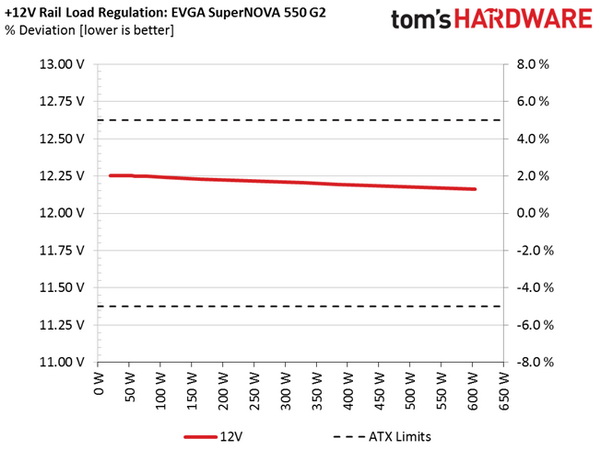
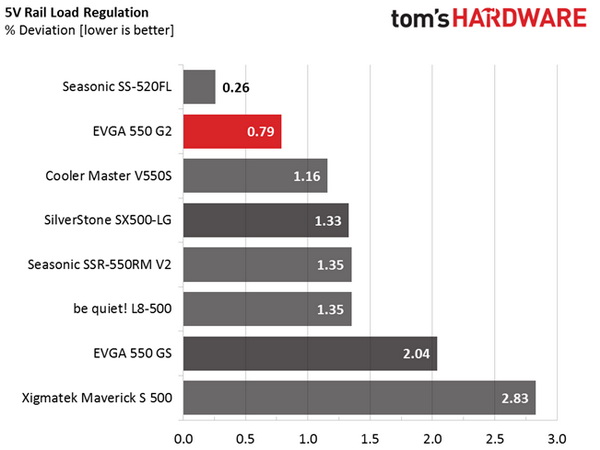
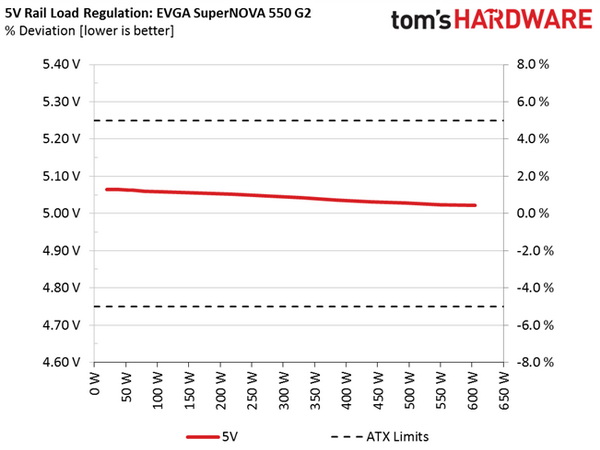
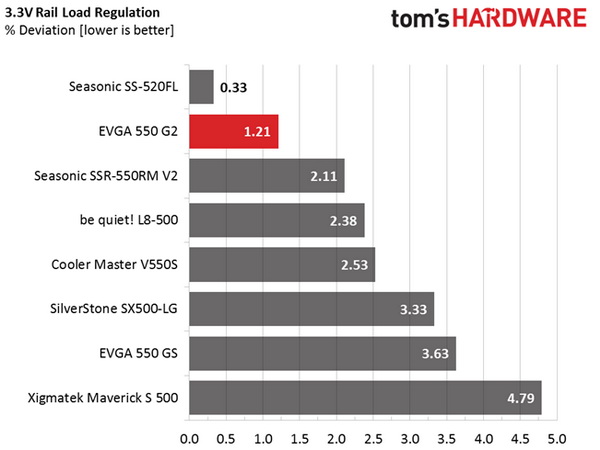
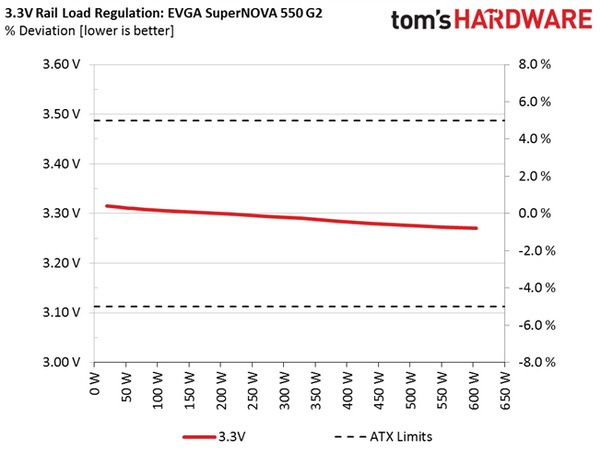
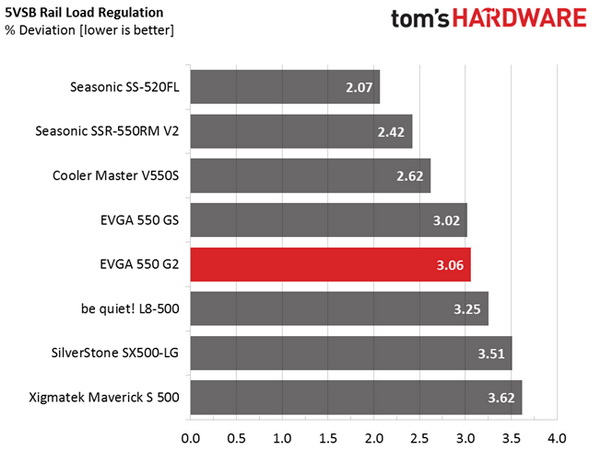
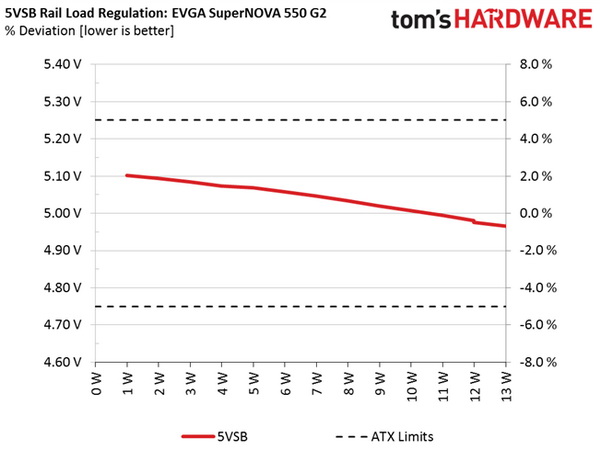
Hold-Up Time
Our hold-up time tests are described in detail here.


The holdup time was less than 16 milliseconds, which means the PSU failed this test.
Inrush Current
For details on our inrush current testing, please click here.
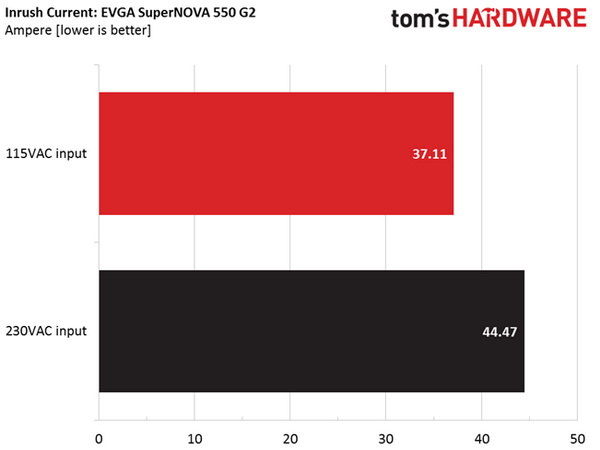
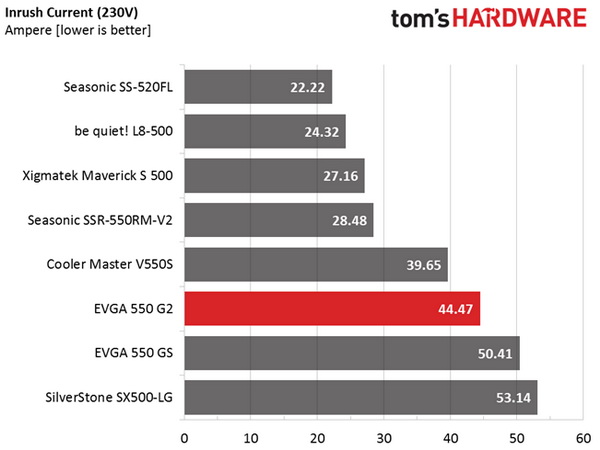
The registered inrush current is at normal levels for a PSU with a 550 W capacity.
Load Regulation And Efficiency Measurements
The first set of tests reveals the stability of the voltage rails and the PSU's efficiency. The applied load equals approximately 10 to 110 percent of the maximum load the supply can handle, in increments of 10 percentage points.
Get Tom's Hardware's best news and in-depth reviews, straight to your inbox.
We conducted two additional tests. During the first, we stressed the two minor rails (5V and 3.3V) with a high load, while the load at +12V was only 0.10A. This test reveals whether a PSU is Haswell-ready. In the second test, we determined the maximum load the +12V rail could handle with minimal load on the minor rails.
| Test | 12V(A/V) | 5V(A/V) | 3.3V(A/V) | 5VSB(A/V) | PowerDC/AC(W) | Efficiency(%) | Fan Speed(RPM) | Fan NoisedB(A) | TempIn/Out(°C) | PF/AC(V) |
|---|---|---|---|---|---|---|---|---|---|---|
| 1 | 2.707A | 1.974A | 1.991A | 0.985A | 54.74 | 84.28 | 1005 | 37.4 | 38.94 | 0.953 |
| 12.253V | 5.062V | 3.310V | 5.069V | 64.95 | 41.98 | 115.1V | ||||
| 2 | 6.447A | 2.958A | 2.992A | 1.185A | 109.77 | 88.07 | 1005 | 37.4 | 39.60 | 0.964 |
| 12.241V | 5.058V | 3.306V | 5.058V | 124.64 | 43.01 | 115.1V | ||||
| 3 | 10.527A | 3.466A | 3.510A | 1.384A | 164.84 | 89.53 | 1065 | 37.6 | 39.93 | 0.978 |
| 12.230V | 5.055V | 3.302V | 5.046V | 184.11 | 43.68 | 115.1V | ||||
| 4 | 14.612A | 3.954A | 3.999A | 1.584A | 219.73 | 90.24 | 1065 | 37.6 | 40.71 | 0.985 |
| 12.222V | 5.052V | 3.299V | 5.034V | 243.50 | 46.46 | 115.1V | ||||
| 5 | 18.363A | 4.957A | 5.007A | 1.788A | 274.77W | 90.12 | 1065 | 37.6 | 40.82 | 0.989 |
| 12.214V | 5.047V | 3.294V | 5.020V | 304.88 | 46.96 | 115.1V | ||||
| 6 | 22.123A | 5.949A | 6.015A | 1.995A | 329.76 | 89.86 | 1080 | 38.3 | 41.21 | 0.991 |
| 12.204V | 5.042V | 3.290V | 5.007V | 366.96 | 47.87 | 115.1V | ||||
| 7 | 25.882A | 6.949A | 7.030A | 2.200A | 384.71 | 89.42 | 1127 | 39.6 | 42.87 | 0.992 |
| 12.195V | 5.036V | 3.285V | 4.994V | 430.25 | 50.42 | 115.1V | ||||
| 8 | 29.639A | 7.947A | 8.048A | 2.408A | 439.58 | 88.87 | 1165 | 41.1 | 43.27 | 0.993 |
| 12.187V | 5.031V | 3.280V | 4.980V | 494.66 | 51.99 | 115.1V | ||||
| 9 | 33.842A | 8.456A | 8.576A | 2.410A | 494.73 | 88.17 | 1190 | 42.9 | 44.12 | 0.993 |
| 12.178V | 5.028V | 3.276V | 4.975V | 561.14 | 54.05 | 115.1V | ||||
| 10 | 37.793A | 8.958A | 9.074A | 3.030A | 549.59 | 87.46 | 1245 | 45.5 | 45.13 | 0.994 |
| 12.169V | 5.024V | 3.273V | 4.946V | 628.41 | 56.13 | 115.1V | ||||
| 11 | 42.342A | 8.965A | 9.081A | 3.031A | 604.57 | 86.81 | 1285 | 46.1 | 45.52 | 0.994 |
| 12.160V | 5.021V | 3.270V | 4.943V | 696.45 | 58.07 | 115.1V | ||||
| CL1 | 0.099A | 13.014A | 13.005A | 0.000A | 109.41 | 82.83 | 1205 | 43.8 | 43.62 | 0.967 |
| 12.260V | 5.035V | 3.281V | 5.080V | 132.09 | 49.20 | 115.1V | ||||
| CL2 | 45.784A | 1.002A | 1.003A | 1.001A | 569.90 | 88.13 | 1240 | 45.2 | 45.14 | 0.994 |
| 12.155V | 5.040V | 3.292V | 5.039V | 646.68 | 55.90 | 115.1V |
Load regulation was tight on all of the rails except the 5VSB rail, where load regulation doesn't play an important role. On top of that, the PSU had no problem delivering its full power for prolonged periods of time at very high ambient temperatures. In addition, the fan's noise wasn't annoyingly high, even during the last two tests (100 percent load and 110 percent load), although we pushed the PSU to its limits. In the efficiency section, the PSU easily cleared the 80 Plus Gold requirements, even in our tough testing conditions. Overall, this is an excellent platform, and EVGA made the right choice to offer it at lower capacities.
Current page: Load Regulation, Hold-Up Time And Inrush Current
Prev Page A Look Inside And Component Analysis Next Page Efficiency, Temperature And Noise
Aris Mpitziopoulos is a contributing editor at Tom's Hardware, covering PSUs.
-
marraco Wow. Ripple behavior is fantastic.Reply
I would like to see another test. I had a PC with a Coolermaster PSU and 4 HD which were put to sleep mode/hibernation. Sometimes when the 4 HD were powered up the PC hanged, because the 4 HD demanded so much transient power that it threw the PSU voltages out of specs.
I was thinking that I had a great PSU, but it was expensive garbage. -
Aris_Mp this scenario is covered by the transient response tests, which I conduct in page #7 of the review.Reply -
giantbucket i don't get it... isn't this like trying to sell a Ferrari with only 3 cylinders to appeal to the sub-$100,000 clientele?Reply -
dstarr3 Super Flower makes some great hardware. I'm all over this for my upcoming modest gaming rig.Reply -
dstarr3 Replyi don't get it... isn't this like trying to sell a Ferrari with only 3 cylinders to appeal to the sub-$100,000 clientele?
The problem is that all of the best-built, best-featured PSUs were being made in 850, 1000, 1200, 1600W variants. If you had just a modest system, something mid-range, you either had to get a PSU that was way overkill, or you had to settle for PSUs that weren't so well built, or as efficient, or as fully-featured. So, this is an attempt to distribute very high-quality products to more of the market. And I am 110% A-Okay with that. -
MasterDell Reply
I agree with this to some extent because there are and were tons of PSU's made by Seasonic. Whether they were Antec units or XFX units OEM'd by Seasonic or not.. They were made by Seasonic. Now, as for fully modular, gold rated variants, those were and still are far and few between. However there are tons of Bronze semi-modular/none modular units which are great for mid-range builds.i don't get it... isn't this like trying to sell a Ferrari with only 3 cylinders to appeal to the sub-$100,000 clientele?
The problem is that all of the best-built, best-featured PSUs were being made in 850, 1000, 1200, 1600W variants. If you had just a modest system, something mid-range, you either had to get a PSU that was way overkill, or you had to settle for PSUs that weren't so well built, or as efficient, or as fully-featured. So, this is an attempt to distribute very high-quality products to more of the market. And I am 110% A-Okay with that.
I actually own this unit and used it in a build with a 960. I got it right when it came out and for it's price, it offered a ton. I live in Canada and PSU's are way over-priced and the prices make no sense on them. But this unit was priced extremely well likely due to it's availability so I picked one up. No problems and I am glad EVGA is filling this market void. Good on em.
-
Nuckles_56 Nice to see a low wattage power supply being reviewed for a change and particularly one which performs very wellReply -
turkey3_scratch I think I found my PSU. I don't need any 750W, but I had trouble finding a high quality 550W unit, and this is it!Reply -
g-unit1111 I have two G2s, these are far and away some of the best PSUs on the market! Good to see that EVGA is making some lower wattage models that have the same quality and consistency.Reply
